

Compact Muon Solenoid
LHC, CERN
| CMS-SMP-20-008 ; CERN-EP-2020-197 | ||
| Search for the rare decay of the W boson into a pion and a photon in proton-proton collisions at $\sqrt{s} = $ 13 TeV | ||
| CMS Collaboration | ||
| 11 November 2020 | ||
| Phys. Lett. B 819 (2021) 136409 | ||
| Abstract: A search is performed for the rare decay $\mathrm{W^{\pm}}\to\pi^{\pm}\gamma$ in proton-proton collisions at $\sqrt{s} = $ 13 TeV. Data corresponding to an integrated luminosity of 137 fb$^{-1}$ were collected during 2016 to 2018. This novel analysis exploits the W boson production in top quark pair events. The leptonic decay of the W boson from one of the top quarks is used to tag the event, and the b quark jets are used to reduce the background from the hadronization of light-flavor quarks and gluons. The W boson originating from the other top quark is used to search for the $\mathrm{W^{\pm}}\to\pi^{\pm}\gamma$ decay. Such events are characterized by an isolated track and an isolated photon of large transverse momentum. The $\mathrm{W^{\pm}}\to\pi^{\pm}\gamma$ decay is not observed. An upper exclusion limit is set to this branching fraction, corresponding to 1.50 $\times 10^{-5}$ at 95% confidence level. | ||
| Links: e-print arXiv:2011.06028 [hep-ex] (PDF) ; CDS record ; inSPIRE record ; HepData record ; CADI line (restricted) ; | ||
| Figures & Tables | Summary | Additional Figures | References | CMS Publications |
|---|
| Figures | |
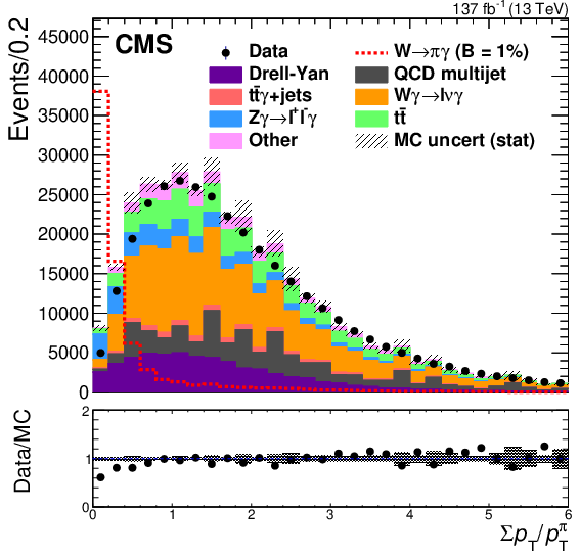
png pdf |
Figure 1:
Event distribution as a function of the pion-isolation variable $\Sigma {p_{\mathrm {T}}} / {p_{\mathrm {T}}} ^{\pi}$. The simulated MC distribution for the signal is given by the dashed red line and corresponds to a 1% branching fraction for the $\mathrm{W^{\pm}} \to \pi^{\pm} \gamma $ decay. The statistical uncertainties in the data are small and thus not visible. In the lower plot, the ratio between data and the background component of the MC is shown. The gray bands represent the statistical uncertainty in the MC background. |

png pdf |
Figure 2:
Event distributions as a function of the BDT discriminant for the muon (left) and electron (right) channels. The green and orange arrows indicate the intervals of the BDT discriminant used to define a signal (SR) and a control region (CR). The signal histogram is enhanced so that the signal and background histograms are normalized to the same area. The statistical uncertainties in the data are small and thus not visible. |
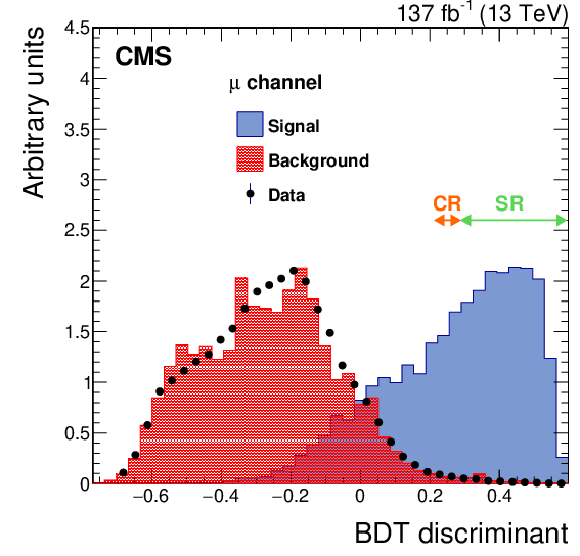
png pdf |
Figure 2-a:
Event distributions as a function of the BDT discriminant for the muon channel. The green and orange arrows indicate the intervals of the BDT discriminant used to define a signal (SR) and a control region (CR). The signal histogram is enhanced so that the signal and background histograms are normalized to the same area. The statistical uncertainties in the data are small and thus not visible. |

png pdf |
Figure 2-b:
Event distributions as a function of the BDT discriminant for the electron channel. The green and orange arrows indicate the intervals of the BDT discriminant used to define a signal (SR) and a control region (CR). The signal histogram is enhanced so that the signal and background histograms are normalized to the same area. The statistical uncertainties in the data are small and thus not visible. |
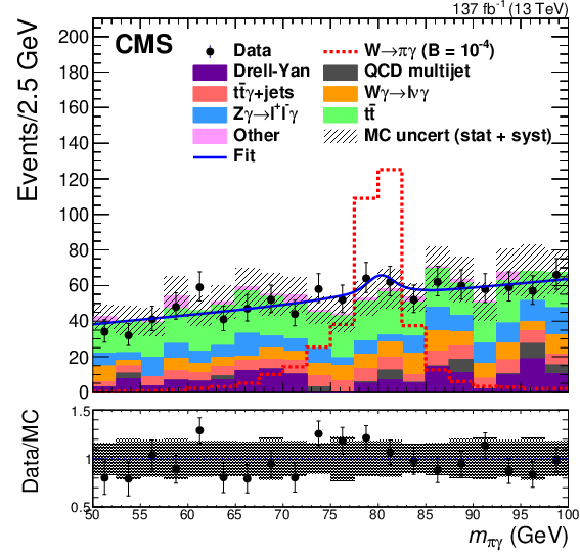
png pdf |
Figure 3:
Event distribution as a function of $ {m_{\pi \gamma}} $ for the combination of the lepton channels. The simulated MC distribution for the signal is given by the dashed red line and corresponds to a $10^{-4}$ branching fraction for the $\mathrm{W^{\pm}} \to \pi^{\pm} \gamma $ decay. The uncertainties in the data are statistical only. The blue line represents the best fit to the data using the model described in Eq. (1). In the lower plot, the ratio between data and the background component of the MC is shown. The gray bands represent the uncertainty (statistical + systematic) in the MC background. |
| Tables | |
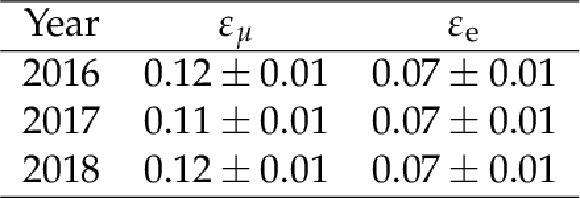
png pdf |
Table 1:
The product of signal efficiency and acceptance per year and per lepton channel. |
| Summary |
| A first search is reported for the rare decay $\mathrm{W^{\pm}}\to\pi^{\pm}\gamma$ at the LHC. The search is based on the proton-proton collision data collected at a center-of-mass energy of 13 TeV at the CMS experiment in 2016-2018, corresponding to an integrated luminosity of 137 fb$^{-1}$. Because of the high trigger thresholds for single photons, which make an inclusive search unsuitable at CMS, the measurement is performed using top quark-antiquark pair events, where one of the produced W bosons decays into leptons. This is the first search for $\mathrm{W^{\pm}}\to\pi^{\pm}\gamma$ that adopts such a strategy. The rare decay is characterized by an isolated track, for which a specific pion-isolation variable is defined, and an isolated photon with large transverse momentum. The data are compatible with the background-only hypothesis. The upper limit on the branching fraction of the W boson to a pion and a photon is 1.50 $\times 10^{-5}$ at the confidence level of 95%. This result demonstrates the feasibility of a search for such rare decays of the W bosons at the LHC and defines a suitable search strategy. |
| Additional Figures | |

png pdf |
Additional Figure 1:
Event distribution as a function of the number of b jets $n_{\mathrm {b}}$ (left) and the pion-isolation variable $\Sigma {p_{\mathrm {T}}} / {p_{\mathrm {T}}} ^{{\pi}}$ (right) after the multivariate selection. The simulated MC distribution for the signal is given by the dashed red line and corresponds to a 10$^{-4}$ branching fraction for the $\to {\pi ^\mathrm {{\pm}}} {\gamma}$ decay. In the lower plots, the ratio between data and the background component of the MC is shown. The gray bands represent the statistical uncertainty in the MC background. The topology with $n_{\mathrm {b}} = $ 0 mainly incorporates events with soft hadronic activity, and is strongly suppressed by the multivariate selection. This results as well in an improved agreement between simulation and collision data for low values of $\Sigma {p_{\mathrm {T}}} / {p_{\mathrm {T}}} ^{{\pi}}$, where mostly particles of low ${p_{\mathrm {T}}}$ contribute to the ${p_{\mathrm {T}}} $-sum. |
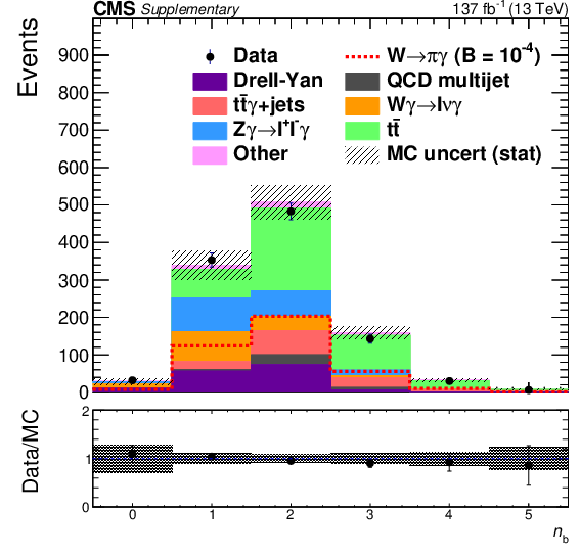
png pdf |
Additional Figure 1-a:
Event distribution as a function of the number of b jets $n_{\mathrm {b}}$ after the multivariate selection. The simulated MC distribution for the signal is given by the dashed red line and corresponds to a 10$^{-4}$ branching fraction for the $\to {\pi ^\mathrm {{\pm}}} {\gamma}$ decay. In the lower plot, the ratio between data and the background component of the MC is shown. The gray band represents the statistical uncertainty in the MC background. The topology with $n_{\mathrm {b}} = $ 0 mainly incorporates events with soft hadronic activity, and is strongly suppressed by the multivariate selection. |

png pdf |
Additional Figure 1-b:
Event distribution as a function of the pion-isolation variable $\Sigma {p_{\mathrm {T}}} / {p_{\mathrm {T}}} ^{{\pi}}$ after the multivariate selection. The simulated MC distribution for the signal is given by the dashed red line and corresponds to a 10$^{-4}$ branching fraction for the $\to {\pi ^\mathrm {{\pm}}} {\gamma}$ decay. In the lower plot, the ratio between data and the background component of the MC is shown. The gray band represents the statistical uncertainty in the MC background. The topology with $n_{\mathrm {b}} = $ 0 mainly incorporates events with soft hadronic activity, and is strongly suppressed by the multivariate selection. This results as well in an improved agreement between simulation and collision data for low values of $\Sigma {p_{\mathrm {T}}} / {p_{\mathrm {T}}} ^{{\pi}}$, where mostly particles of low ${p_{\mathrm {T}}}$ contribute to the ${p_{\mathrm {T}}} $-sum. |
| References | ||||
| 1 | Y. Grossman, M. Konig, and M. Neubert | Exclusive radiative decays of W and Z bosons in QCD factorization | JHEP 04 (2015) 101 | 1501.06569 |
| 2 | T. Melia | Exclusive hadronic W decay: $ \mathrm{W}\to\pi\gamma $ and $ \mathrm{W}\to\pi\pi\pi $ | Nucl. Part. Phys. Proc. 273 (2016) 2012 | |
| 3 | G. Perez, Y. Soreq, E. Stamou, and K. Tobioka | Prospects for measuring the Higgs boson coupling to light quarks | PRD 93 (2016) 013001 | 1505.06689 |
| 4 | M. Mangano and T. Melia | Rare exclusive hadronic W decays in a $ \mathrm{t\bar{t}} $ environment | EPJC 75 (2015) 258 | 1410.7475 |
| 5 | CDF Collaboration | Search for the rare radiative decay: $ \mathrm{W}\to\pi\gamma $ in $ \mathrm{p\bar{p}} $ collisions at $ \sqrt{s} = $ 1.96 TeV | PRD 85 (2012) 032001 | 1104.1585 |
| 6 | CDF Collaboration | Search for the rare decay $ \mathrm{W^{\pm}}\to \mathrm{{D}^{\pm}_{s}}\gamma $ in $ \mathrm{p\bar{p}} $ collisions at $ \sqrt{s} = $ 1.8 TeV | PRD 122 (1998) 091101 | |
| 7 | CMS Collaboration | Search for W boson decays to three charged pions | PRL 122 (2019) 151802 | CMS-SMP-18-009 1901.11201 |
| 8 | Particle Data Group, P. Zyla et al. | Review of particle physics | Prog. Theor. Exp. Phys. 2020 (2020) 083C01 | |
| 9 | CMS Collaboration | The CMS trigger system | JINST 12 (2017) P01020 | CMS-TRG-12-001 1609.02366 |
| 10 | CMS Collaboration | The CMS experiment at the CERN LHC | JINST 3 (2008) S08004 | CMS-00-001 |
| 11 | T. Sjostrand et al. | An introduction to PYTHIA 8.2 | CPC 191 (2015) 159 | 1410.3012 |
| 12 | P. Nason | A new method for combining NLO QCD with shower Monte Carlo algorithms | JHEP 11 (2014) 040 | hep-ph/0409146 |
| 13 | S. Frixione, P. Nason, and C. Oleari | Matching NLO QCD computations with parton shower simulations: the POWHEG method | JHEP 11 (2017) 070 | 0709.2092 |
| 14 | S. Alioli, P. Nason, C. Oleari, and E. Re | A general framework for implementing NLO calculations in shower Monte Carlo programs: the POWHEG BOX | JHEP 06 (2010) 043 | 1002.2581 |
| 15 | J. M. Campbell, R. K. Ellis, P. Nason, and E. Re | Top-pair production and decay at NLO matched with parton showers | JHEP 04 (2015) 114 | 1412.1828 |
| 16 | J. Alwall et al. | The automated computation of tree-level and next-to-leading order differential cross sections, and their matching to parton shower simulations | JHEP 07 (2014) 079 | 1405.0301 |
| 17 | NNPDF Collaboration | Parton distributions for the LHC Run II | JHEP 04 (2015) 040 | 1410.8849 |
| 18 | NNPDF Collaboration | Parton distributions from high-precision collider data | EPJC 77 (2017) 663 | 1706.00428 |
| 19 | CMS Collaboration | Event generator tunes obtained from underlying event and multiparton scattering measurements | EPJC 76 (2016) 155 | CMS-GEN-14-001 1512.00815 |
| 20 | CMS Collaboration | Extraction and validation of a new set of CMS PYTHIA8 tunes from underlying-event measurements | EPJC 80 (2020) 4 | CMS-GEN-17-001 1903.12179 |
| 21 | CMS Collaboration | Measurement of the $ \mathrm{t\bar{t}} $ production cross section using events in the $ \Pe\PGm $ final state in $ {\mathrm{p}}{\mathrm{p}} $ collisions at $ \sqrt{s}= $ 13 TeV | EPJC 77 (2017) 172 | CMS-TOP-16-005 1611.04040 |
| 22 | GEANT4 Collaboration | GEANT4--a simulation toolkit | NIMA 506 (2003) 250 | |
| 23 | CMS Collaboration | Particle-flow reconstruction and global event description with the CMS detector | JINST 12 (2017) P10003 | CMS-PRF-14-001 1706.04965 |
| 24 | M. Cacciari, G. P. Salam, and G. Soyez | The anti-$ {k_{\mathrm{T}}} $ jet clustering algorithm | JHEP 04 (2008) 063 | 0802.1189 |
| 25 | M. Cacciari, G. P. Salam, and G. Soyez | FastJet user manual | EPJC 72 (2012) 1896 | 1111.6097 |
| 26 | CMS Collaboration | Performance of missing transverse momentum reconstruction in proton-proton collisions at $ \sqrt{s} = $ 13 TeV using the CMS detector | JINST 14 (2019) P07004 | CMS-JME-17-001 1903.06078 |
| 27 | CMS Collaboration | Performance of the CMS muon detector and muon reconstruction with proton-proton collisions at $ \sqrt{s} = $ 13 TeV | JINST 13 (2018) P06015 | CMS-MUO-16-001 1804.04528 |
| 28 | CMS Collaboration | Performance of electron reconstruction and selection with the CMS detector in proton-proton collisions at $ \sqrt{s} = $ 8 TeV | JINST 10 (2015) P06005 | CMS-EGM-13-001 1502.02701 |
| 29 | CMS Collaboration | Performance of photon reconstruction and identification with the CMS detector in proton-proton collisions at $ \sqrt{s} = $ 8 TeV | JINST 10 (2015) P08010 | CMS-EGM-14-001 1502.02702 |
| 30 | CMS Collaboration | Identification of heavy-flavour jets with the CMS detector in $ {\mathrm{p}}{\mathrm{p}} $ collisions at 13 TeV | JINST 13 (2018) P05011 | CMS-BTV-16-002 1712.07158 |
| 31 | CMS Collaboration | Jet energy scale and resolution in the CMS experiment in $ {\mathrm{p}}{\mathrm{p}} $ collisions at 8 TeV | JINST 12 (2017) P02014 | CMS-JME-13-004 1607.03663 |
| 32 | M. J. Oreglia | A study of the reactions $\psi' \to \gamma\gamma \psi$ | PhD thesis, Stanford University, 1980 SLAC Report SLAC-R-236, see A | |
| 33 | CMS Collaboration | CMS luminosity measurement for the 2016 data-taking period | CMS-PAS-LUM-15-001 | CMS-PAS-LUM-15-001 |
| 34 | CMS Collaboration | CMS luminosity measurement for the 2017 data-taking period at $ \sqrt{s} = $ 13 TeV | CMS-PAS-LUM-17-004 | CMS-PAS-LUM-17-004 |
| 35 | CMS Collaboration | CMS luminosity measurement for the 2018 data-taking period at $ \sqrt{s} = $ 13 TeV | CMS-PAS-LUM-18-002 | CMS-PAS-LUM-18-002 |
| 36 | CMS Collaboration | Description and performance of track and primary-vertex reconstruction with the CMS tracker | JINST 9 (2014) P10009 | CMS-TRK-11-001 1405.6569 |
| 37 | T. Junk | Confidence level computation for combining searches with small statistics | NIMA 434 (1999) 435 | hep-ex/9902006 |
| 38 | A. L. Read | Presentation of search results: the $ \mathrm{CL_s} $ technique | JPG 28 (2002) 2693 | |

|
Compact Muon Solenoid LHC, CERN |

|

|

|

|

|

|